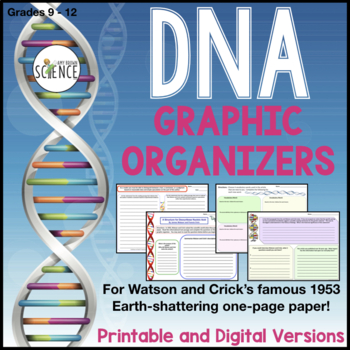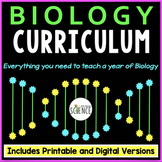- Zip
- Google Apps™

Also included in
- This complete teaching unit on DNA, RNA, and Protein Synthesis includes everything you need to teach this unit to your life science or biology students. Resources include a 120-slide PowerPoint presentation packed with colorful and interesting photographs and images, teacher notes, printable and diPrice $49.99Original Price $67.95Save $17.96
- This NO PREP, PRINTABLE, EDITABLE, AND DIGITAL Biology Curriculum contains everything you need for an entire year of Biology! For less than $3 a day, you can save your time, energy, and sanity. Each of the 20 Complete Units includes a teaching PowerPoint presentation, notes, labs, homework assignmenPrice $525.00Original Price $988.18Save $463.18
Description
This free DNA text reading activity is based on Watson and Crick's famous one-page article published in 1953 in Nature magazine, announcing their discovery of the structure of the DNA molecule. It comes with graphic organizers to help your students read and understand this classic scientific paper. Choose to use the traditional printable version, or the paperless, digital Google Apps version. Both Google Slides and Google Forms versions are included.
This is a fantastic way to teach students how to read scientific texts and articles. Students will read the one-page paper and complete a 4-page set of graphic organizers. Each graphic organizer page can be used alone or in combination with the other pages.
This activity is intended to be used with high school biology students. Students will gain experience in reading scientific journal articles and will be exposed to a major event in the history of science.
This article and accompanying graphic organizers are perfect for:
- Classwork or homework assignment.
- A quick and ready lesson for your substitute folder.
- Early finishers.
- Any Common Core lesson on information text.
Included in this product:
- Watson and Crick Paper
- Copyright Information
- Teacher Guide and Instructions for Use
- Printable Four-page Set of Graphic Organizers
- Teacher Answer Key
- Paperless Digital Version for use in Google Drive, Google Classroom, and /or Microsoft OneDrive
- Google Slides Version (not editable)
- Google Forms Version (editable)
The graphic organizers look best when printed in color, but print perfectly fine if you print using the grayscale setting on your printer.
Related resources include:
DNA, RNA, and Protein Synthesis Google Sheets Hidden Picture Reveal Games
Biology Buzz Words: DNA, RNA, and Protein Synthesis
DNA, RNA, and Protein Synthesis Complete Teaching Bundle
Science Reading Task Cards (Set of 75 cards)
For updates about sales and new products, please follow my store:






